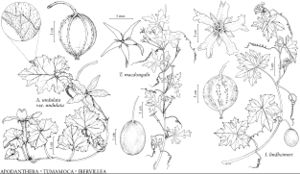Tumamoca
Contr. U.S. Natl. Herb. 16: 21, plate 17. 1912.
| Taxon | Illustrator ⠉ | |
|---|---|---|
 | Apodanthera undulata var. undulata Tumamoca macdougalii Ibervillea lindheimeri | Yevonn Wilson-Ramsey Yevonn Wilson-Ramsey Yevonn Wilson-Ramsey |
Plants perennial, monoecious and dioecious (developmentally, seasonally), trailing or climbing; stems perennial proximally, annual distally, woody, glabrous [hispid-hirsute or hispidulous]; roots tuberous; tendrils unbranched. Leaves: petiolar region an extension of blade midportion; blade ovate to orbiculate, deeply 3-lobed, lobes 1–2-lobed, ultimate segments narrow, margins entire, surfaces eglandular at base. Inflorescences: staminate flowers 2–19 in axillary, subsessile racemes; pistillate flowers solitary, from same axils as staminate; bracts absent. Flowers: hypanthium narrowly tubular-funnelform; sepals 5, deltate to triangular; petals 5, distinct, pale-yellow to greenish yellow, narrowly triangular to linear-lanceolate, valvate in bud, 4–6 mm, apex entire, glabrous, corolla salverform. Staminate flowers: stamens 3; filaments inserted at hypanthium rim, distinct, nearly vestigial; thecae distinct, oblong, connective narrow, each with glabrous, narrow, exserted, terminal appendage nearly as long as corolla; pistillodes absent. Pistillate flowers: ovary 3-locular, ellipsoid; ovules ca. 2–6 per locule; style 1, narrowly columnar; stigmas 3, coiled; staminodes 3. Fruits berrylike, red or yellow, globose, 0.8–1 cm, smooth, glabrous, irregularly dehiscent. Seeds 8–20, obovoid to ovoid, compressed, arillate, margins obscure, surface tuberculate-rugose.
Distribution
Arizona, n Mexico
Discussion
Species 2 (1 in the flora)
Tumamoca is closely related to Ibervillea. Plants of both genera produce orange to red fruits with prominently margined, red-arillate seeds. Tumamoca is distinct in its narrowly funnelform hypanthium (versus narrowly campanulate to cylindric in Ibervillea), three staminodes (versus five), entire petals (versus apices bifid), interior corolla surfaces glabrous (versus densely pubescent), valvate buds (versus buds with infolded apices), and seeds with roughened surfaces and obscure margins (versus corky-pleated surfaces and raised margins).
Tumamoca mucronata Kearns apparently is known only from the type locality in northwestern Zacatecas, Mexico.
Selected References
None.